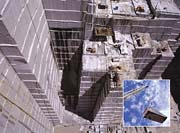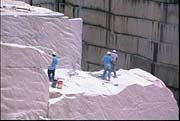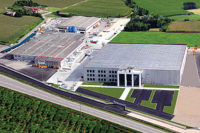
The E.L. Smith Quarry was purchased by Rock of Ages Corp. in the 1940s. Today, the quarry is over 500 feet in depth and is believed to be the world's largest dimension "deep-hole" granite quarry. The quarry, which yields mostly light and medium shades of Barre Gray granite, accounts for about 70% of the total production of Barre granite quarried each year.
Part of what is now the Wells-Lamson Quarry was originally the first-known quarry on Millstone Hill, opened by Abijah Abbott in about 1825. His son, Richard F. Abbott, joined the business in 1834 after the tavern he operated in present-day East Barre burned to the ground. The heirs of Richard Abbott operated the quarry until 1883, when it was purchased by three investors: J.K. Pirie, George Lamson and Sydney Wells. They ran the quarry in conjunction with their other quarry holdings. Sydney Wells retired, leaving the firm in 1891. George Lamson died in 1902. At that time, the quarry was then taken over by the heirs of George Lamson. It was later purchased by the Jones Brothers Granite Co. Rock of Ages bought the quarry in 1986, making Rock of Ages the exclusive quarrier of Barre Gray granite. The quarry is currently being developed as an aggregate quarry, supplying granite that is then crushed for use in road construction.

Modern quarrying operations
As visitors approach the Rock of Ages complex in Barre, they are greeted by large piles of granite, flanking the roads like silent sentinels from days of yore. They prompt one of the most frequently asked questions: "What are those large piles of granite?"Some of the granite quarried is not suitable for use as a finished product due to cracks, spots and other natural imperfections. The amount of usable granite varies markedly from quarry to quarry, and even within quarries themselves. E.L. Smith Quarry has an outstandingly high recovery rate due to the homogeneous texture and quality of the granite. It boasts an incredible 75% recovery rate.
The waste stone is called "grout," a Scottish word meaning "waste." In the past, the grout was piled as close to the work sites as possible due to the difficulty of transporting the heavy stone. This practice later necessitated the moving of the many piles at great expense in order to develop new quarry areas. Today, the grout is dumped on sub-marginal lands that are not expected to be quarried in the future. The grout is now backfilled rather than piled.
Despite numerous and creative attempts at utilizing the grout, no practical, economically viable use has been found. However, some of the grout from newly developed areas of the quarries and from older sections of the quarries is sold to other companies, which crush the stone. This crushed stone is suitable for roadbeds, landscaping and many other purposes. The grout created from the regular quarrying process is often unsuited for crushed stone, since the pieces are too large to be crushed economically. These blocks are occasionally used for piers, breakwaters or fill.
The next structures to strike the eyes of a visitor to Rock of Ages are the large derricks (fixed cranes) that tower above the quarries. The derricks are some of the most important pieces of equipment used on the quarries. Not only are they required to lift all of the granite blocks from the deep-hole quarries, but they are also used to move equipment in and out of the quarries and to transport the workforce.
The first derricks used in Barre consisted of horse-driven sweeps connected to systems of gears. Steam-powered derricks were first used in Barre in about 1870. These wooden structures were made from mammoth Douglas fir trees brought in by rail from Oregon and Washington states. Many of these derricks towered 115 feet in height and were capable of lifting 40 tons. Lifting capacities steadily increased as derrick systems were improved. By the 1970s, these wooden derricks were being systematically replaced by modern steel derricks. Today, there are no wooden derricks operating in any of the Barre quarries. The steel derricks range from 110 to 160 feet tall and vary in lifting capacity from 100 to 250 tons.
The derricks are composed of a vertical pole, called the "mast," and a horizontal beam angling outward and upward from the base, called the "boom." All the derricks are connected (guyed) to each other at the top in such a manner that a solid strain is exerted from the opposite side, no matter in what direction the boom is extended. These wire cables are called "sky-guys." Another network of guy cables secures each derrick to the earth by several cables attached to granite ledges, to granite blocks or to man-made blocks, called "deadmen." More than 15 miles of 1 1? and 1 3?inch diameter wire cables criss-cross the top of E.L. Smith Quarry.
Today the derricks are driven by electronically powered hoists, which are located in small buildings, called "hoist houses." These houses are placed at various distances from the base of each derrick and are operated by skilled workers, known as "hoist engineers." Since these hoist operators cannot see into the quarry from their vantage points in the hoist houses, they must rely on signalmen or "derrickmen" who stand in railed areas near the edge of the quarry. The derrickman uses an intricate set of hand signals to relay information from the workers at the bottom of the quarry to the engineer in the hoist house.
When an area of the quarry is temporarily "worked out," or a new section is to be opened, it is then necessary to literally move an entire derrick to a new location. This move is a tremendous feat of engineering accomplished by a group of technicians referred to as "riggers." Riggers move, maintain and repair the derricks, often climbing to the top of the masts to perform routine safety inspections or repairs.
At the bottom of most quarries is a pool of water -- an accumulation of underground water, rain and the water used in "wet drilling," a process that suppresses dust when cutting the stone. Pumps work constantly to keep the quarries dry, the water being utilized in both the Barre quarrying and manufacturing operations. Water is used for dust control and as a coolant for drills, saws and other machinery.
Early quarrying was an arduous task. Workers relied upon hand drills, black powder and brute force to wrest the granite from the earth. In the 1870s, the introduction of steam-powered drills and derricks improved the efficiency of the extraction process. Continual refinements in machinery eased somewhat the burden of the quarriers. Although air-driven (pneumatic) equipment was first utilized for finishing granite in Barre granite sheds as early as 1892, it was not until 1903 that the first pneumatic plug drills were used in the Barre quarries; and many steam-driven drills operated in the Barre quarries until the 1920s.
Today a variety of equipment is used in the Barre quarries to perform the basic four-step recovery process:
1. A channel is cut (by one of three methods) to free the mass vertically from the quarry walls. The average-size mass channeled from the wall is about 40 x 30 x 17 feet.
2. Pneumatic equipment is then used to drill holes horizontally at the base of the mass, approximately 6 inches on the center. These holes are called "lift" holes. Explosives are placed in the lift holes and detonated to free the channeled mass.
3. Deep holes are then drilled along the "hardway" to break up the large, channeled mass into smaller "line" granite from which standard-size saw blocks can be cut.
4. Once the "hardway" line is broken free, the resulting pieces are ready to be cut into standard-size blocks. This procedure is accomplished by drilling a series of holes of 3?inch diameter about 3 inches apart. Plug wedges and shims are then inserted and driven in with an 8-pound sledgehammer to split the block free.
Usually, several of these proceeding steps are done simultaneously.
Channeling methods
Rock of Ages Corp. currently employs three different methods of channeling in its quarry operations. Each method has specific advantages and disadvantages that determine under what conditions it is best utilized. Water is used in conjunction with each cutting method to suppress dust, control heat and wash detritus from the cut.One method of channeling involves the use of the slot-drill, a pneumatically powered drill. It is used to drill a series of vertical holes 2 1?inches in diameter, approximately 4 1?inches apart. After these holes are drilled, a 3-inch diameter bit is then used to drill or core the "web," the small amount of granite that remains between the previously drilled holes. This "coring" process removes all of the granite between the holes, creating a channel between the mass being quarried and the quarry walls. As a result of this method, the channel has a corrugated appearance.
Another method of channeling utilizes a diamond-wire saw. This device consists of a portable diesel engine, a pulley and a set of small tracks. A vertical and a horizontal hole are drilled with a conventional pneumatic drill so that they meet at a right angle. A strand of wire with "beads" containing industrial grade diamond is then fed through the holes and looped around the pulley wheel driven by the engine. The wire is then clamped together, forming a continuous loop. As the wheel spins, the diamond wire is drawn through the granite. The proper tension is maintained as the stone is cut by the moving of the entire saw unit along the set of rails.
The third method of channeling used is the waterjet. The waterjet is powered by a portable diesel engine, which is housed in a unit separate from the cutting unit containing nozzles and tracking system. Normally, waterjet channeling begins with conventional pneumatic drilling. A pilot hole is drilled, which serves as the starting point for the water jet wand. Oscillating nozzles shoot water at a pressure of 40,000 pounds per square inch. Unlike waterjets used in many other industries, this cutting method does not mix water with abrasive, such as garnet. The pressure of the water is the sole cutting agent. The automated wand containing the nozzles moves vertically, cutting at speeds of up to 40 square feet per hour.
As the vertical channeling process is being completed with the slot drill, diamond-wire saw or the waterjet, a horizontal cut, called the "lift" cut, is being effected by pneumatic drilling. The work is done from a ledge below the work site (if one exists) or from a staging platform that is suspended against the face at the point where the cut is to be made. A pneumatically powered drill, called a "lift hole" drill, is placed so that it is perpendicular to the quarry wall. This drill cuts a series of holes that are approximately 6 inches on center. The resulting row of holes extends completely beneath the block being cut, reaching from the face of the quarry to the channel line at the back of the block, meeting the channel line at approximately a 90-degree angle. Once this series of holes has been completed, every other hole or every third hole is filled with primer cord, a type of explosive. The controlled detonation is set off electrically, causing the granite to crack along the drill lines, separating the large block from the quarry wall. The entire block lifts about an inch or so and then comes to rest once more, remaining in place.

Drilling methods
The large block now separated from the quarry wall by the channel and lift cut is referred to as a "bench," and it is typically about 40 feet long, 30 feet wide, and 15 to 17 feet in height. In 1912, Boutwell, Milne & Varnum Co. channeled the largest block of granite on record, containing about 500,000 cubic feet of granite. This mammoth stone was 200 feet long, 80 feet wide and 25 feet thick. Its estimated weight was 65 million pounds (32,500 tons). The blocks cut from it filled 1,728 freight cars.Once the channel lines and lift cut have been completed and around the bench, this massive block must be divided up into smaller blocks before being lifted from the quarry by a derrick. A double deep-hole drill, a pneumatically powered, rotary drill, is used to cut the block along the "hardway," the direction in which it is hardest to cut the stone. This process is somewhat analogous to cutting wood against its grain. Because the granite will not split easily along its hardway, a series of vertical holes are drilled approximately 4 inches apart. The double deep-hole drill derives its name from its ability to cut two of these holes simultaneously. Each hole is drilled 15 to 17 feet deep, the entire depth of the bench. The resulting row of holes form a "hardway line." A series of hardway lines are cut, the rows being spaced about 5 feet apart. Once these rows of holes have been completed, long, tapered metal wedges, called "gluts," are driven into the holes with a jackhammer. The stress caused the granite to split along the hardway lines, dividing the bench into smaller pieces.
Once the hardway lines are broken free, the resulting pieces are drilled once more along the "rift" or "grain." Granite splits or cleaves much more easily along its rift. Small, pneumatically powered plug drills are then used to sink holes of about 3¿inch in diameter and 6 inches in depth about every 3 inches to form a row of holes or "rift line." Wedges and shims are inserted into these holes and driven in with an 8-pound sledgehammer to split the block along its rift.
After the hardway and rift lines have been split, the resulting dimensioned block is ready to be removed from the quarry. The standard block removed is approximately 10 x 5 x 5 feet and weighs over 20 tons. The block is removed by a loop of wire-cable that is tightly "cinched" around the block. Notches are cut into the corners of the block to prevent the cable from slipping. The clasp is designed so that as more pressure is exerted on the cable, the tighter the "cinch" becomes. The block is then lifted from the quarry by one of the derricks. The heaviest such block ever lifted from the Barre quarries was about 40 feet long, 8 feet wide and 6 feet high and weighed over 190 tons.
Once the blocks reach the surface of the quarry, they are handled and transported by heavy-duty diesel trucks and fork loaders. Blocks are taken to storage areas where each is meticulously graded and then inventoried. Here, buyers come from all over the world to purchase premium Rock of Ages granite. Today, these blocks are shipped primarily by diesel flatbed trucks; but prior to 1957, Rock of Ages transported all of its granite by rail. The company operated its own rail line within its extensive Barre quarry complex, utilizing its own locomotives and specialized rail cars.
The manufacturing division of Rock of Ages Corp. is the single largest customer of its quarry division, purchasing choice blocks of granite for use in the creation of its fine memorials and mausoleums, as well as for the fabrication of its precision surface plates, machine bases and press rolls. Those blocks destined to bear the name of "Rock of Ages" begin their transformation into finished goods at the saw plant.
